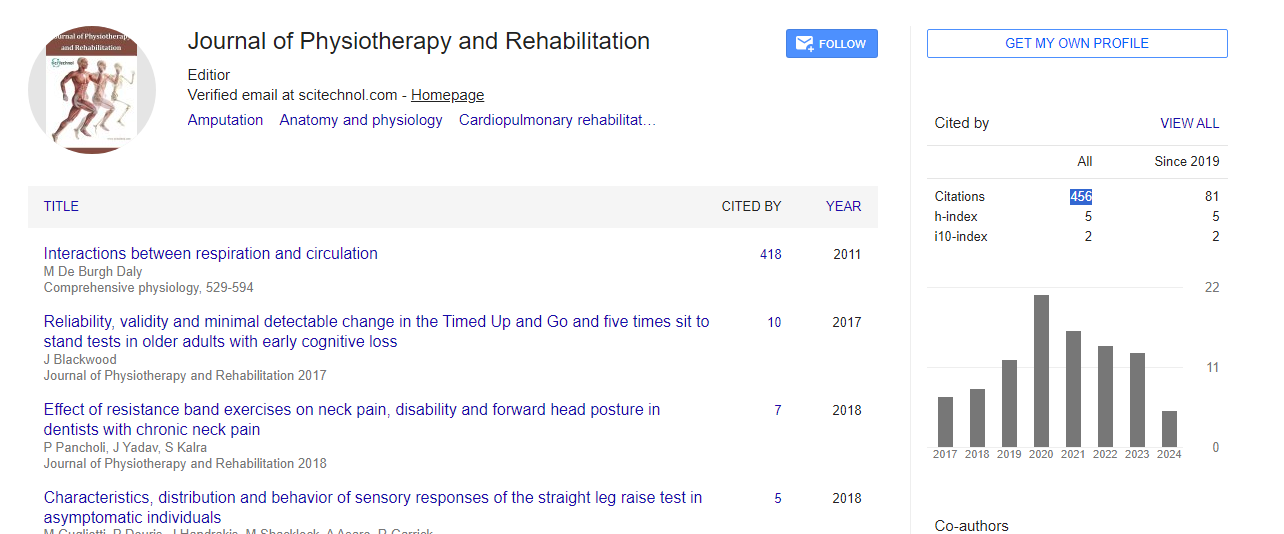Commentary, J Physiother Rehabi Vol: 8 Issue: 23
Rehabilitation Strategies for Musculoskeletal Injuries in Athletes
Ram Riwaz*
1Department of Rehabilitation Medicine, Tsudanuma Central General Hospital, Narashino, Japan
*Corresponding Author: Ram Riwaz,
Department of Rehabilitation Medicine,
Tsudanuma Central General Hospital, Narashino, Japan
E-mail: rizra@raedu.jp
Received date: 28 May, 2024, Manuscript No. JPTR-24-140177;
Editor assigned date: 30 May, 2024, PreQC No. JPTR-24-140177 (PQ);
Reviewed date: 13 June, 2024, QC No. JPTR-24-140177;
Revised date: 21 June, 2024, Manuscript No. JPTR-24-140177 (R);
Published date: 28 June, 2024, DOI: 10.4172/JPTR.1000168.
Citation: Riwaz R (2024) Rehabilitation Strategies for Musculoskeletal Injuries in Athletes. J Physiother Rehabi 8:3.
Description
Musculoskeletal injuries are common among athletes and can significantly impact their performance and career longevity. Effective rehabilitation strategies are important for ensuring a swift and safe return to sport while minimizing the risk of re-injury. Musculoskeletal injuries involve damage to the muscles, bones, ligaments, tendons, or other structures within the musculoskeletal system. Common types of injuries include sprains, strains, fractures, tendinopathies, and joint dislocations. These injuries can arise from acute trauma, overuse, or a combination of both, depending on the sport and level of activity.
The rehabilitation process begins with a thorough assessment and diagnosis. Accurate diagnosis involves a combination of clinical evaluation, imaging techniques (such as MRI or ultrasound), and understanding the mechanism of injury. Assessing the severity and specific nature of the injury allows for tailored rehabilitation plans that address the unique needs of each athlete. During the acute phase, the primary goal is to manage pain and inflammation while preventing further injury. Immediate interventions include the R.I.C.E protocol (Rest, Ice, Compression, Elevation), which helps control swelling and pain. Pharmacological treatments such as Non-Steroidal Anti- Inflammatory Drugs (NSAIDs) may also be prescribed. The focus is on protecting the injured area and promoting an optimal healing environment.
As the initial pain and swelling subside, the rehabilitation program progresses to Restoring Range of Motion (ROM) and strength. Gentle passive and active ROM exercises are introduced to prevent joint stiffness and maintain flexibility. This phase often incorporates manual therapy techniques such as joint mobilization and soft tissue massage to enhance ROM and alleviate muscle tightness. Strengthening exercises are gradually introduced, starting with isometric exercises to activate the muscles without joint movement, followed by concentric and eccentric strengthening exercises. It is essential to address not only the injured area but also the surrounding muscles to prevent compensatory patterns that could lead to additional injuries.
Functional rehabilitation focuses on restoring the athlete's ability to perform sport-specific movements and skills. This phase involves dynamic and functional exercises that mimic the demands of the athlete's sport. Balance and proprioception training is critical to enhance neuromuscular control and reduce the risk of re-injury. Plyometric exercises are often incorporated to improve power and explosiveness, while agility drills help in refining movement patterns. The goal is to progressively increase the intensity and complexity of exercises to ensure that the athlete can perform at their pre-injury level or higher.
Rehabilitation is not solely physical; addressing the psychological aspects is equally important. Athletes may experience anxiety, frustration, or fear of re-injury, which can hinder their recovery. Incorporating psychological support through counseling, mental imagery, and relaxation techniques can enhance motivation and confidence. Educating athletes about the rehabilitation process and setting realistic goals can also contribute to a positive mindset. Modern technology plays a significant role in enhancing rehabilitation outcomes. Wearable devices and motion capture systems provide realtime feedback on biomechanics and performance, allowing for precise adjustments in training. Virtual Reality (VR) and Augmented Reality (AR) are emerging tools that offer immersive environments for sportspecific training and rehabilitation.
Tele-rehabilitation has also gained traction, enabling remote monitoring and guidance for athletes who may not have immediate access to rehabilitation facilities. This approach ensures continuity of care and allows for personalized adjustments based on the athlete's progress. The final phase of rehabilitation focuses on a safe return to play. This involves a gradual reintroduction to training and competition, ensuring that the athlete meets specific criteria for strength, ROM, functional performance, and psychological readiness. Functional testing and assessments help in determining the athlete's readiness and identifying any residual deficits. Injury prevention strategies are integrated into the rehabilitation process to minimize the risk of future injuries. This includes educating athletes on proper techniques, incorporating injury prevention exercises into their routine, and ensuring adequate rest and recovery.
Conclusion
Effective rehabilitation strategies for musculoskeletal injuries in athletes require a multifaceted approach that combines evidence-based practices, individualized treatment, and modern technology. By addressing the physical, functional, and psychological aspects of recovery, athletes can achieve optimal outcomes and return to their sport with confidence. Emphasizing injury prevention and ongoing support further ensures that athletes maintain their performance and reduce the risk of future injuries.
 Spanish
Spanish  Chinese
Chinese  Russian
Russian  German
German  French
French  Japanese
Japanese  Portuguese
Portuguese  Hindi
Hindi 